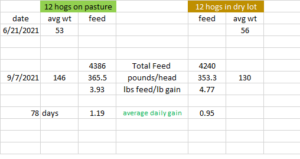Final report for FNC20-1253
Project Information
Both pastured hogs and drylot hogs have been raised at Grain Place Foundation (GPF) for years, and both have been fed by-products from the on-farm organic grain processing and packaging operation. However, the free-range hogs have been in one large 5+ acre field with poor pasture, limited shade, and no quantitative comparisons with other hogs raised in drylot. All practices with the organic certified crops farm have been a part of a nine-year crop/beef cattle grazing rotation since 2002, but hogs have not been integrated into the crop production system except in their consumption of by-products from processing. A gateway to more intense integration is seen in the conversion of the 5-acre grazing area to a silvopastoral system with improved drainage, terraces, and seeding a better pasture mix so that hogs can be managed with rotational grazing and consume part of their feed source from fallen nuts and fruits from trees added to the area. Eventually the plan is to include multi-species grazing by adding beef cattle and/or sheep to this biodiverse silvopastoral area, but first we want to quantify the benefits of grazing on diverse feed sources on rates of gain in hogs as compared to a nearby drylot hog feeding enterprise keeping all other factors the same. The hypothesis to test is that hogs grazing on multiple feed sources in a rotational pattern will out-perform those in the drylot, confirming non-statistical observations from the past decade. Prior sustainable practices were integration of the feed source with the processing operation, and the long-term goal is to further integrate hogs, sheep, and cattle into grazing on the long-term rotation plots that average 8 acres in size and have pasture in three of the nine years of the rotation. This will provide an excellent visual and statistical comparison for biodiverse crop/livestock demonstrations during the annual field days, and with data provided on the GPF web site and through Extension at University of Nebraska.
Silvopasture hog production can diversify enterprises and spread income sources throughout the year. Quality pasture and/or fallen fruits and nuts can reduce feed costs and lower supplemental by-product feeding from on-farm grain processing. After land shaping to improve drainage, fruit and nut trees will be planted in improved pasture with a quality species mix, and rotational grazing used in a 5.3 acre renovated pasture. Preliminary results have shown grazing hogs on this organic farm reaching sale weight of 275# at least two months sooner than drylot hogs fed only grain by-products on the same farm. If these outcomes are validated, we will introduce the grazing practice in a nearby two-replication, nine-year grain/pasture rotation. This will include tree planting in field boundaries as a supplemental feed source for hogs and a diversified habitat for beneficial insects. We will demonstrate the crop/animal system to area farmers on annual field days and disseminate results through Cooperative Extension. Trees and pasture fields will capture and cycle N (resource stewardship), provide higher profits (improved economics), and produce quality pork for sale to local community customers (social responsibility). The research and demonstrations will be accomplished on land of Grain Place Foundation in Nebraska’s Platte River Valley.
- Evaluate the potential for silvopasture hog production on a renovated marginal field through improved drainage, quality pasture seeding, trees for shade and fruit/nut production, and combined forage and grain processing by-products as an on-farm feed source.
- Compare rates of gain and time to market weight of pastured hogs with a nearby drylot system using only grain by-products from the same source.
- Conduct two field-day demonstrations of the silvopasture system and disseminate results through multiple media and Cooperative Extension.
- If results are favorable, incorporate multiple-species grazing into an adjacent organic crop/pasture nine-year rotation experiment.
Cooperators
- - Producer (Researcher)
- - Producer (Educator)
Research
Land modifications, planting plans, grazing strategies, and comparisons of two hog production systems were summarized, including outreach details and where results could make an impact. The 5.3 acre field renovated has poor drainage, marginal pasture growth, and limited potential for crop or livestock production. Well-designed terraces and drainage ways, planting improved pasture species, and trees along contours and field boundaries provided demonstrations for improving marginal crop land. Fruit and nut trees supplemented pasture and grain by-products, plus provided shade for hogs in the silvopastoral system with weight gains compared to drylot grainfed production.
Expertise and equipment was hired for the major earth work. Pasture mixtures used locally-available seed, with seeding accomplished with planting equipment available on the farm. Adapted fruit/nut varieties were sourced locally, or propagated from trees on the farm with demonstrated adaptation and productivity. Trees needed exclusion fencing for several years, since grazing can commence when growth is adequate. Evaluations in the first years included pastured hogs versus nearby drylot hogs; assessment of fruits and nuts in hog diets is beyond the funding of this project. Initial hog weights and time to market weights were compared between two systems. Rotational grazing of the renovated field was initiated as soon as pasture has adequate growth and cross-fencing and water can be provided.
Results were demonstrated to farmers, FFA members, and university students potential productivity of diversified fields, compared to conventional monoculture corn. Accounting of inputs for field modification, and costs of production/incomes for two systems was used in outreach activities.
Viewing field transformations will motivate farmers to innovate at home. Practical publications and webinars included all steps in renovation, plus comparative production and profits, for classroom and extension activities.
Update, November 2023-The land modifications, including designed terraces and drainage ways, pasture mix planting and much of the fencing was completed in the first two years of the project. The first planting of trees on the terraces failed, so this year a second set was put in with an 80% establishment rate as recently reviewed. This will be reviewed again in the spring to determine the survival rate over the winter.
The pasture was established and the exclusion fencing for the trees was built. The pasture was then incorporated into the cattle’s grazing rotation, but we did not feel it was ready yet to introduce the pressure of the hogs. We then selected another area of the farm which was in its last year of pasture before rotating back to grain production to use for our comparison of free-range pigs versus dry lot pigs.
A second extension of the grant was given as requested which enabled us to gain another year of data. This was necessary because it is very difficult to find a source for outside pigs. This took us a while and, at my wife’s suggestion, we finally found a family showing for 4-H at our county fair that is supplying for us now.
We received 30 pigs on the farm and when the fencing was ready split them into two groups. One group stayed on the dry lot on full feed.
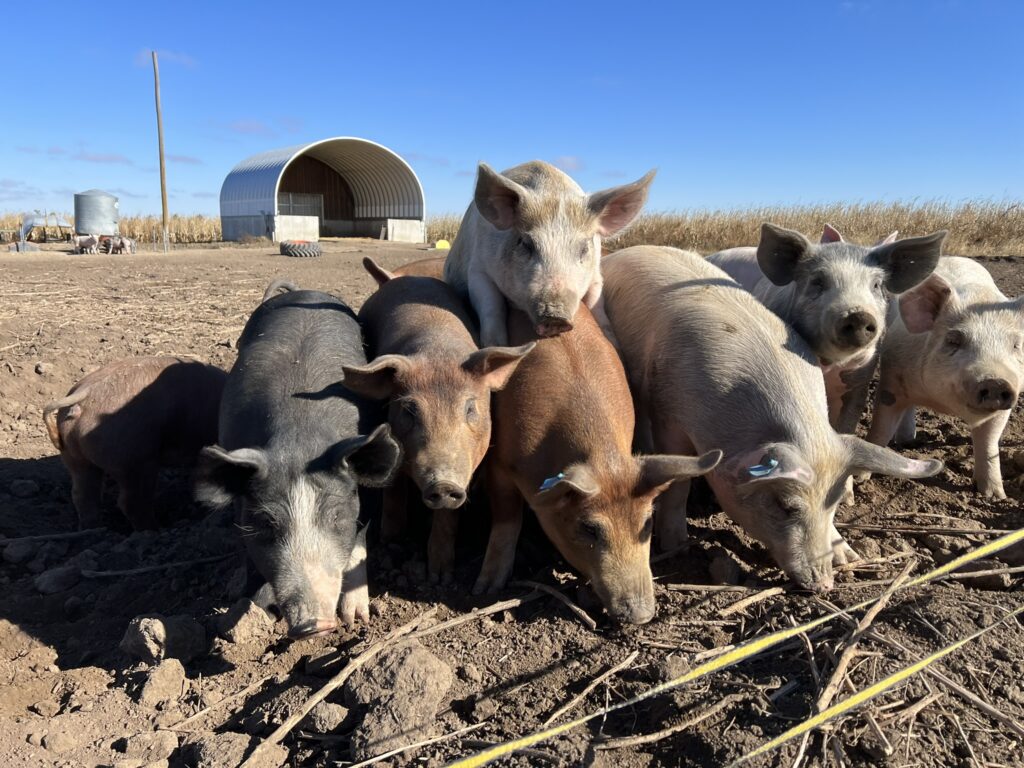
The other group was taken, with an un-roadworthy stock trailer, to about 2.5 acres of an alfalfa field on full feed with a small pond and trees beside it.
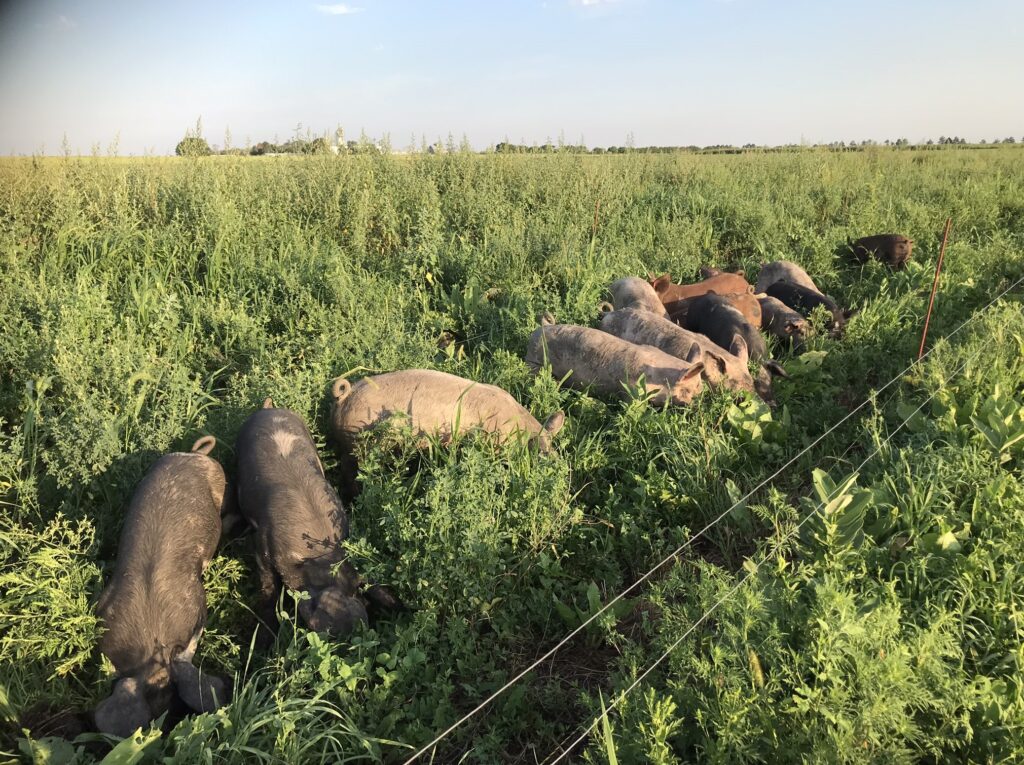
Robert Wattermann took leadership in this and first tried giving hogs access to long narrow strips of the alfalfa (~300’ X 15’). He found that it was unrealistically labor intensive to use the long and narrow format with the fencing system in use, so he adapted the design to fewer, much wider strips. However, as he continued observing the behavior of the pigs, he noticed that they ranged quite well, and avoided too much rooting in one location; this was contrary to expectations. Based on this observation, he removed one of the paddock wires and let them have access to an entire side of the field, occasionally moving the interior border line, which would give the pigs a smaller section and let more of the pasture recover. They continued to range widely, evenly pressuring all the pasture they had access to. This setup also helped maintain fence power, which was very difficult given the low fence line needed for pigs and the lush greenery of the pasture. Pastured pig fencing systems on a medium-large scale with rotating fields needs more development to be efficient and effective.
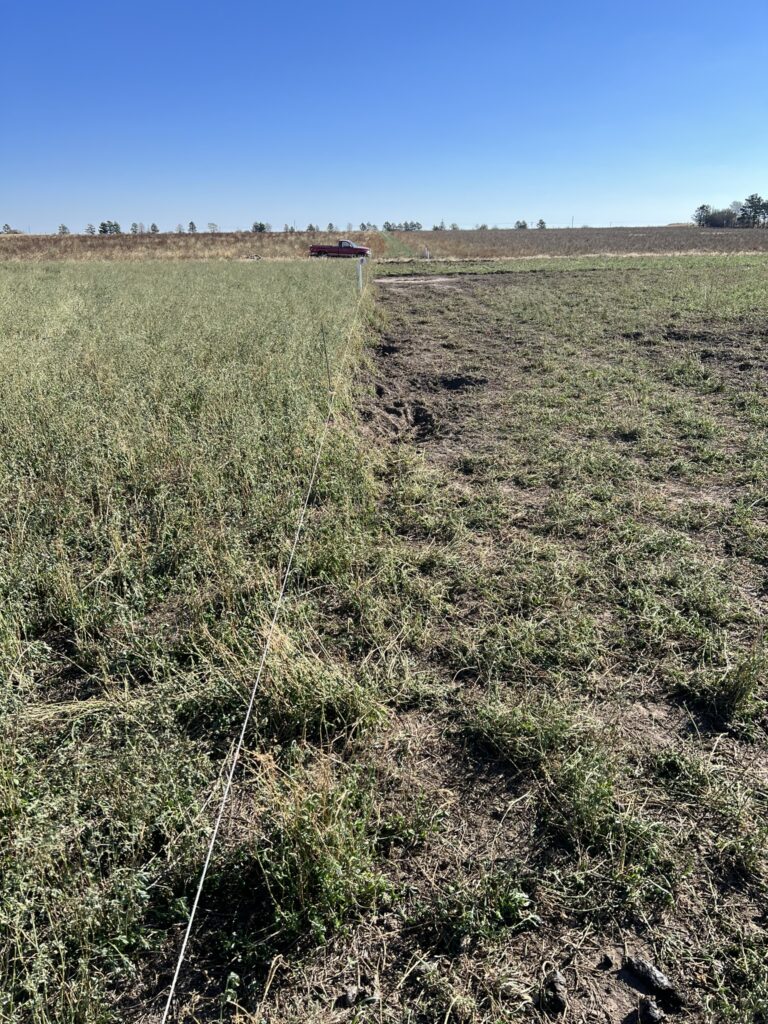
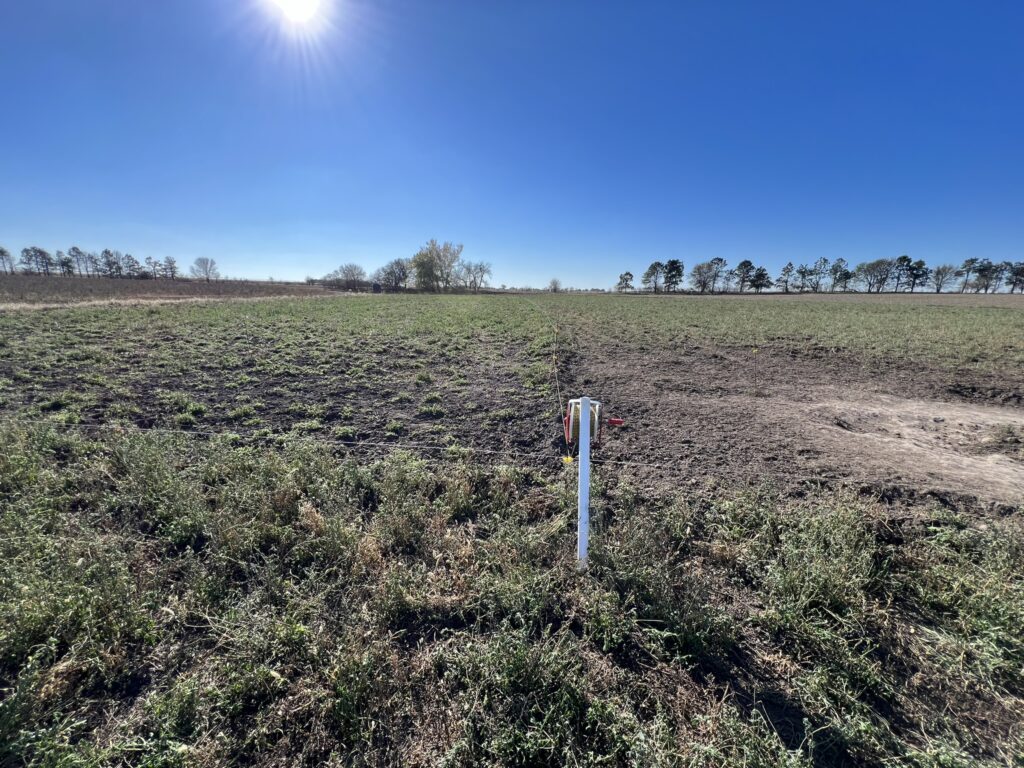
The stock trailer was left near the pond with straw in it which the pigs used to sleep in. This worked very good as a shelter and proved useful as anytime we wanted to weigh the pigs, we just shut the door in the morning before they were out, hooked on to it, and headed for our scale. It should be noted that pigs will invariably harm wiring systems on equipment left within reach.
The pigs were often seen wallowing in the small pond under the trees during the very hot parts of this last summer which seemed to keep them very happy.
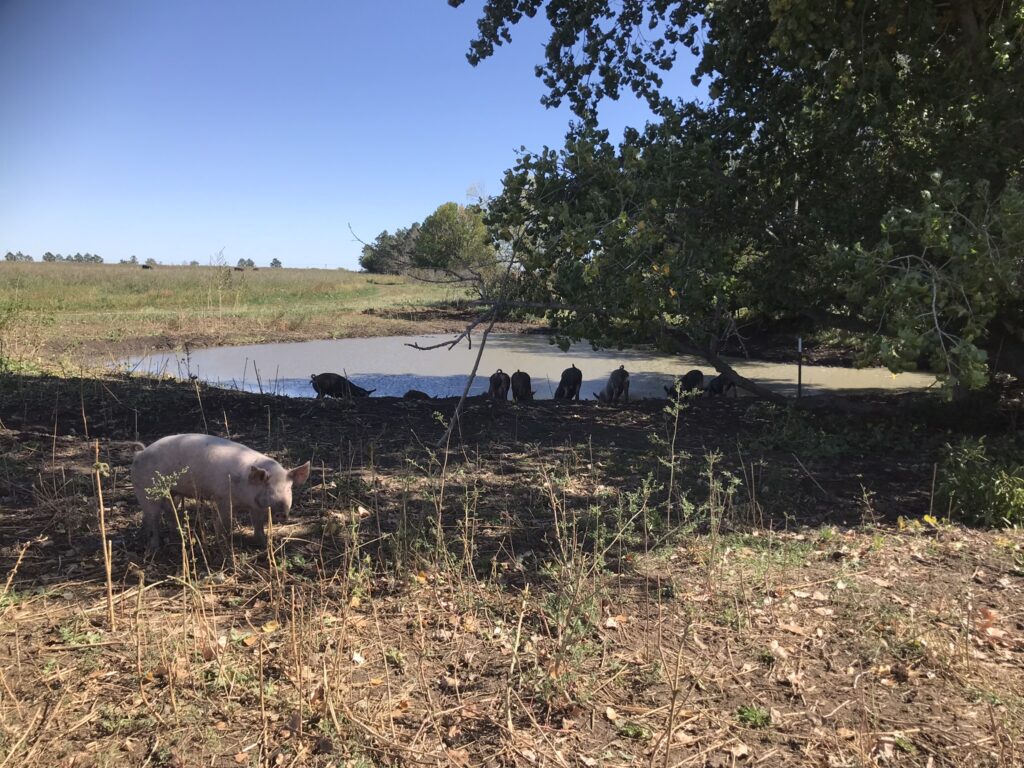
We had to occasionally run water in the dry lot to create and maintain a wallow for those pigs which they also enjoyed, but for shade they had only their hoop house, no trees.
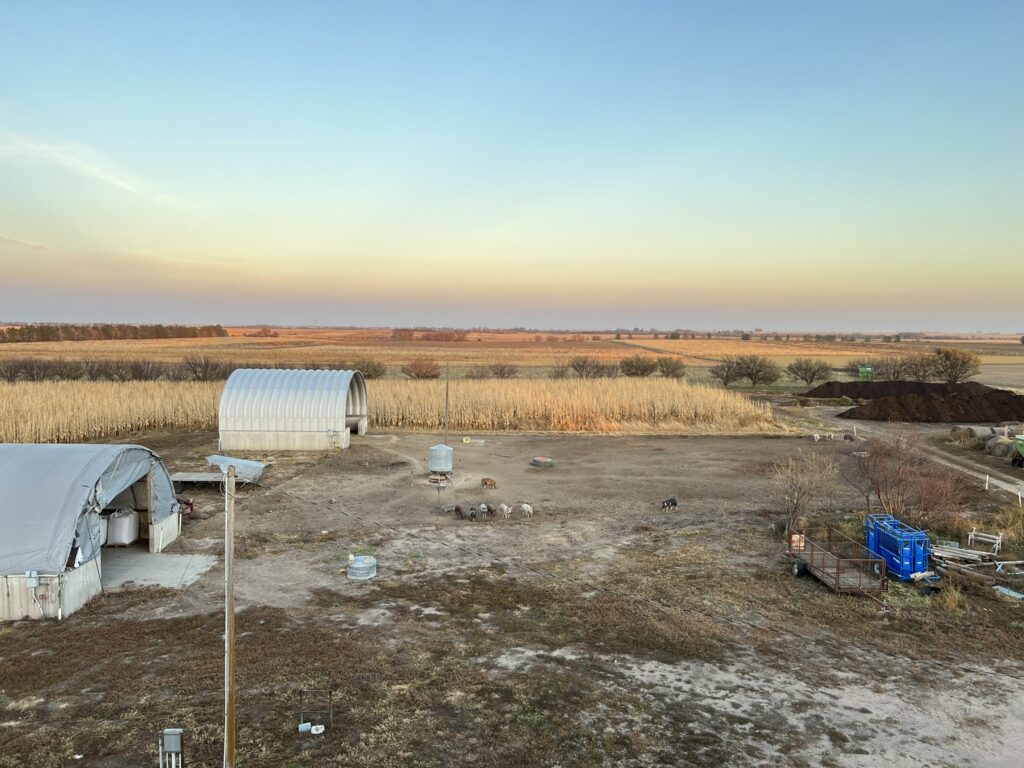
Preliminary plans and design of on-farm comparison of free-range versus drylot raised feeder pigs were described to visitors who participated in the virtual field day in July [due to COVID-19 there was no in-person field day this past summer]. The silvopastoral swine comparison with drylot was described and shown in a brief video overview of Grain Place Foundation and the adjacent Grain Place Foods that was part of the ZOOM farm tour. This was before the new pastures were established and young trees were barely visible. A similar virtual tour was prepared for the summer 2021 field day in July, but results of the comparison were not be available until Year 3. We requested and recieved a no-cost extension of the grant to be able to present results in an in-person field day in July, 2022. These results will also be summarized with photos and data in a final project report, and publicized through the GPF web site and in other press releases.
We continue to be thankful for the SARE grant and the improvements we have been able to do on the farm because of this special support.
As stated in earlier reports, we re-established terraces around the field we dedicated to silvopasture, re-seeded the field and planted some trees along the top of the terraces, laid down a drip irrigation line to water the trees and put up an electric fence around the inside of the terraces for later grazing.
The new seeding was able to get established in most of the pasture and in those areas that were weak we added new seeds in a second planting. Because of this, we didn’t feel the pasture could withstand the pressure that pigs would put on it so we have not yet put pigs in this area. We have, however, grazed the project area this past year with two bulls for 13 days, 50 cattle for three days and 9 heifers for 8 days.
Last year we took a small section of one of our pastures that we were going to turn back to grain production and divided it into several sections to rotate the pigs through. We divided our herd, put one on the rotating pastures and one in our dry lot and kept records of feed consumption and weight gain. The summary was in an attached sheet in last year’s report.
An interesting, albeit unwelcome, result was the area we had under the pastured pigs had much greater weed pressure this year when we rotated it into grain production. Part of the reason was we held the pigs in some of the lots longer hoping to put pressure on bindweed problems we have in them. This in fact proved to be the case, less bindweed but more of other weeds. We expect to reduce this impact significantly in fields with less bindweed by rotating the pigs more often and look forward to seeing if that is the case.
We planned to repeat that process but our pig supplier shut down and we were unable to get enough pigs to hold another comparison until November 2, 2022. This was too late to put pigs out on pasture because we have no way to keep water to them when it freezes and do not yet have shelter to protect them from the cold. Therefore, we do not have any data from this past year.
Concerning the establishment of fruit and nut species, the original project coordinator was very slow in getting them placed in the ground and had no follow-up on them. When he left we had an intern install hoses for a drip system but she was unable to get it completed before she left. This was a serious problem because for more than a year now we have been experiencing very dry conditions. This past year also we have been short staffed on the farm so this is one area that suffered. Consequently, very few of the new plantings are viable at this time.
We have just hired a young man who will come on staff for the farm the end of this month which should take care of the labor shortage. Now that we have help, if we secure further funds, we could replant the trees where we now have the drip system, and we could acquire the needed shelters for the pastured pigs.
In spite of concluding our agreement with SARE, we are planning to repeat the comparison in 2023 when we get the next group of pigs. We already know which pastures we will put them on, water is already there in the summer and we know how we will manage the feed. We hope to get another year’s extension on the final report in order to add statistics to the pastured/dry lot pigs comparison. Even if we do not get an extension, we would be happy to submit our findings.
Update, November 2023-
Feed consumption and weight gain:
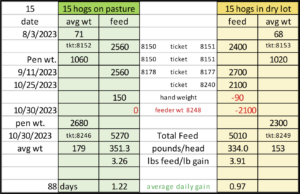
From these scale tickets we can see several things;
The pasture pigs ate 5.2% more feed than the dry lot pigs.
The pasture pigs gained 19.9% more weight per pound of feed.
The pasture pigs average daily rate of gain was 26.2% greater than the dry lot pigs.
One interesting note is we can still see a significant reduction in the bindweed in the paddock we intentionally pressured fairly hard with the pigs two years ago.
Educational & Outreach Activities
Participation Summary:
Plans for the on-farm comparison of rates of gain for silvopastoral free-range hogs compared to a matched lot of drylot-raised hogs were described to farmers and other professionals in the virtual field day in July. Progress in land shaping and tree planting for the free-range swine comparison with drylot feeding was shown as part of a brief video overview of Grain Place Foundation operations during the ZOOM farm tour. Trees and pasture should be well established and a new batch of hogs in each system will be carefully matched by initial weights for feeding in this second year, thus some results will be available by the scheduled end of grant in late 2021. Two years of results will not be available until a year later. A one-year no-cost extension of the grant will be needed to complete two years of comparisons. Two years of results will be summarized with photos and data in a final project report, and publicized at field days, through the GPF web site and in other press releases.
Update, November 2023-
We held our annual field day in July this year (2023) and a special tour of interested participants went down to look at the pastured pigs and talk about what we have learned and how they might integrate something similar in their operations.
We gave a presentation about our project to an audience of ~15 for the 2023 Annual Food and Farm Conference in Topeka, Kansas on November 11, as one of several presenters in the NCR-SARE Farmers Forum part of the event.
We happily maintain a readiness to discuss and advise anyone who is interested in what we found, or how this information might be used on their farms.
Learning Outcomes
We learned several lessons from the first year of the grant, including the importance of careful budgeting of expenses, how essential it is to have clear plans to cope with any unexpected change in leadership of a project, the length of time it takes to accomplish multiple and sequential tasks (earth works for drainage, planting trees, planting new pasture species, and starting to fence the area), and coping with a serious nutrient deficiency in both groups of hogs that was not anticipated due to the feed source from gleanings from the organic seed processing on farm. All of these have been overcome, and with the additional needed fencing we will be prepared for a new batch of hogs in each system this spring. Advantages of a project such as this include data from a practical on-farm comparison of two swine systems that will be visible to field day visitors with realistic on-farm results, and demonstrating how integration of on-farm processing can provide a grain feed source for two methods of fattening hogs. Disadvantages are the long-term challenges of establishing a silvo-pastoral research facility with adequate drainage and high-quality pastures; also the additional feed source from fruits and nuts from the trees will not be available until well beyond the two-year scope of the initial grant. One recommendation for other farmers who want to integrate potentials for combining crop production, processing, and feeding by-products is to test feeds well ahead of time to solve nutrition problems, and to seek sources of research support that can cover at least five years of implementation that will give viable results and make them available to other farmers.
Update, November 2023-
There is clear evidence that giving pigs free range on pasture allows them to perform much better.
By further management such as utilizing rotation it is possible to keep the pigs from hurting the land with too much rooting. In contrast, with very intensive grazing of the pigs, where they are encouraged to root deeply, it is possible to significantly reduce bindweed infestations. Under this study we have seen this as a viable method of bindweed control, and we plan to incorporate it as part of regular bindweed management for our row crops.
Efficient and effective fencing for rotating pastured pigs badly needs further development.
We also noticed that the pastured pigs became significantly more aggressive in behavior compared to the dry lot pigs. We suspect that this is because the dry lot pigs were much closer to human activity and therefore were more used to seeing and interacting with people and machinery.
Project Outcomes
None
We recommend that SARE continue to solicit integrated crop/livestock projects that are longer in duration, with recognition that these projects are more difficult to propose and take more time for results to emerge. The SARE farmer/rancher projects continue to be an effective source of stimulation for operators to try new innovations and where a small grant can have a large multiplier effect. In general, SARE funding has been at least level and often increased every year for more than two decades, and this is a rare occurrence in the arena of federal funding. Thanks for the support.
